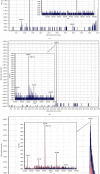Evaluation of the Therapeutic Effects of the Hydroethanolic Extract of Portulaca oleracea on Surgical-Induced Peritoneal Adhesion
- PMID: 34381307
- PMCID: PMC8352699
- DOI: 10.1155/2021/8437753
Evaluation of the Therapeutic Effects of the Hydroethanolic Extract of Portulaca oleracea on Surgical-Induced Peritoneal Adhesion
Abstract
Objective: Peritoneal adhesion (PA) is an abnormal connective tissue that usually occurs between tissues adjacent to damaged organs during processes such as surgery. In this study, the anti-inflammatory and antioxidant effects of Portulaca oleracea (PO) were investigated against postoperative-induced peritoneal adhesion.
Methods: Thirty healthy male Wistar rats (220 ± 20 g, 6-8 weeks) were randomly divided into four groups: (1) normal, (2) control (induced peritoneal adhesion), and (3) and (4) PO extracts (induced peritoneal adhesion and received 100 or 300 mg/kg/day of PO extract for seven days). Finally, macroscopic and microscopic examinations were performed using different scoring systems and immunoassays in the peritoneal lavage fluid.
Results: We found that the levels of adhesion scores and interleukin- (IL-) 1β, IL-6, IL-10, tumour necrosis factor- (TNF-) α, transforming growth factor- (TGF-) β 1, vascular endothelial growth factor (VEGF), and malondialdehyde (MDA) were increased in the control group. However, PO extract (100 and 300 mg/kg) notably reduced inflammatory (IL-1β, IL-6, and TNF-α), fibrosis (TGF-β 1), angiogenesis (VEGF), and oxidative (MDA) factors, while increased anti-inflammatory cytokine IL-10, antioxidant factor glutathione (GSH), compared to the control group.
Conclusion: Oral administration of PO improved postoperational-induced PA by alleviating the oxidative factors, fibrosis, inflammatory cytokines, angiogenesis biomarkers, and stimulating antioxidative factors. Hence, PO can be considered a potential herbal medicine to manage postoperative PA. However, further clinical studies are required to approve the effectiveness of PO.
Copyright © 2021 Ali Jaafari et al.
Conflict of interest statement
The authors declare that there is no conflict of interest.
Figures







Similar articles
-
Evaluation of the effects of Iranian propolis on the severity of post operational-induced peritoneal adhesion in rats.Biomed Pharmacother. 2018 Mar;99:346-353. doi: 10.1016/j.biopha.2018.01.068. Epub 2018 Feb 20. Biomed Pharmacother. 2018. PMID: 29665643
-
Standardised pomegranate peel extract lavage prevents postoperative peritoneal adhesion by regulating TGF-β and VEGF levels.Inflammopharmacology. 2021 Jun;29(3):855-868. doi: 10.1007/s10787-021-00819-6. Epub 2021 May 15. Inflammopharmacology. 2021. PMID: 33993390
-
Anti-Inflammatory and Anti-Oxidant Activity of Portulaca oleracea Extract on LPS-Induced Rat Lung Injury.Molecules. 2019 Jan 1;24(1):139. doi: 10.3390/molecules24010139. Molecules. 2019. PMID: 30609661 Free PMC article.
-
The role of growth factors in peritoneal healing: transforming growth factor beta (TGF-beta).Eur J Surg Suppl. 1997;(577):17-23. Eur J Surg Suppl. 1997. PMID: 9076448 Review.
-
The multiple roles of macrophages in peritoneal adhesion.Immunol Cell Biol. 2025 Jan;103(1):31-44. doi: 10.1111/imcb.12831. Epub 2024 Oct 29. Immunol Cell Biol. 2025. PMID: 39471989 Review.
Cited by
-
Establishment of pelvic inflammatory disease model induced by vaginal injection of Ureaplasma urealyticum liquids combined with fatigue and hunger.Anim Reprod. 2023 Oct 30;20(3):e20220106. doi: 10.1590/1984-3143-AR2022-0106. eCollection 2023. Anim Reprod. 2023. PMID: 38025994 Free PMC article.
-
HPLC/MS characterization of Syzygium aromaticum L. and evaluation of its effects on peritoneal adhesion: Investigating the role of inflammatory cytokines, oxidative factors, and fibrosis and angiogenesis biomarkers.Physiol Rep. 2023 Jan;11(2):e15584. doi: 10.14814/phy2.15584. Physiol Rep. 2023. PMID: 36695659 Free PMC article.
-
The Therapeutic Potential of Targeting Key Signaling Pathways as a Novel Approach to Ameliorating Post-Surgical Adhesions.Curr Pharm Des. 2022;28(45):3592-3617. doi: 10.2174/1381612828666220422090238. Curr Pharm Des. 2022. PMID: 35466868 Review.
-
Edible Herbal Medicines as an Alternative to Common Medication for Sleep Disorders: A Review Article.Curr Neuropharmacol. 2024;22(7):1205-1232. doi: 10.2174/1570159X21666230621143944. Curr Neuropharmacol. 2024. PMID: 37345244 Free PMC article. Review.
-
Punica granatum seed oil detracts peritoneal adhesion: Perusing antioxidant, anti-inflammatory, antifibrotic, and antiangiogenic impacts.Physiol Rep. 2022 Dec;10(24):e15545. doi: 10.14814/phy2.15545. Physiol Rep. 2022. PMID: 36541264 Free PMC article.
References
-
- Moreno A., Aguayo J. L., Zambudio G., Ramirez P., Canteras M., Parrilla P. Influence of abdominal incision on the formation of postoperative peritoneal adhesions: an experimental study in rats. The European Journal of Surgery. 1996;162(3):181–185. - PubMed
MeSH terms
Substances
LinkOut - more resources
Full Text Sources
Medical

